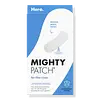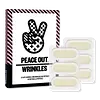What's inside
What's inside
 Key Ingredients
Key Ingredients

 Benefits
Benefits

 Concerns
Concerns

 Ingredients Side-by-side
Ingredients Side-by-side

Sodium Hyaluronate
HumectantWater
Skin ConditioningNiacinamide
SmoothingGlycerin
HumectantAdenosine
Skin ConditioningRetinol
Skin ConditioningHyaluronic Acid
HumectantPolysorbate 80
EmulsifyingPropanediol
SolventCamellia Sinensis Leaf Extract
AntimicrobialSclerotium Gum
Emulsion StabilisingXanthan Gum
EmulsifyingMadecassoside
AntioxidantPentylene Glycol
Skin ConditioningCentella Asiatica Extract
CleansingButylene Glycol
Humectant1,2-Hexanediol
Skin ConditioningSodium Dehydroacetate
PreservativeLeuconostoc/Radish Root Ferment Filtrate
AntimicrobialCollagen
MoisturisingAcetyl Hexapeptide-8
HumectantEthylhexylglycerin
Skin ConditioningSodium Hyaluronate, Water, Niacinamide, Glycerin, Adenosine, Retinol, Hyaluronic Acid, Polysorbate 80, Propanediol, Camellia Sinensis Leaf Extract, Sclerotium Gum, Xanthan Gum, Madecassoside, Pentylene Glycol, Centella Asiatica Extract, Butylene Glycol, 1,2-Hexanediol, Sodium Dehydroacetate, Leuconostoc/Radish Root Ferment Filtrate, Collagen, Acetyl Hexapeptide-8, Ethylhexylglycerin
Sodium Hyaluronate
HumectantCellulose Gum
Emulsion StabilisingTrehalose
HumectantGlycerin
HumectantPropanediol
SolventButylene Glycol
HumectantCaprylyl Glycol
EmollientRetinol
Skin ConditioningAdenosine
Skin ConditioningCarnosine
Skin ConditioningAscorbic Acid
AntioxidantPalmitoyl Tripeptide-1
Skin ConditioningBiotinoyl Hexapeptide-2 Amide
Skin ConditioningAcetyl Octapeptide-3
HumectantPalmitoyl Pentapeptide-4
Skin ConditioningPalmitoyl Tetrapeptide-7
Skin ConditioningAcetyl Hexapeptide-8
HumectantHeptasodium Hexacarboxymethyl Dipeptide-12
Skin ConditioningMelatonin
AntioxidantMadecassoside
AntioxidantEthylhexylglycerin
Skin ConditioningCarbomer
Emulsion StabilisingPolysorbate 80
EmulsifyingPolysorbate 20
Emulsifying1,2-Hexanediol
Skin ConditioningSodium Lactate
BufferingSodium Hyaluronate, Cellulose Gum, Trehalose, Glycerin, Propanediol, Butylene Glycol, Caprylyl Glycol, Retinol, Adenosine, Carnosine, Ascorbic Acid, Palmitoyl Tripeptide-1, Biotinoyl Hexapeptide-2 Amide, Acetyl Octapeptide-3, Palmitoyl Pentapeptide-4, Palmitoyl Tetrapeptide-7, Acetyl Hexapeptide-8, Heptasodium Hexacarboxymethyl Dipeptide-12, Melatonin, Madecassoside, Ethylhexylglycerin, Carbomer, Polysorbate 80, Polysorbate 20, 1,2-Hexanediol, Sodium Lactate
Ingredients Explained
These ingredients are found in both products.
Ingredients higher up in an ingredient list are typically present in a larger amount.
1,2-Hexanediol is a synthetic liquid and another multi-functional powerhouse.
It is a:
- Humectant, drawing moisture into the skin
- Emollient, helping to soften skin
- Solvent, dispersing and stabilizing formulas
- Preservative booster, enhancing the antimicrobial activity of other preservatives
Acetyl Hexapeptide-8, commonly known as Argireline or Acetyl Hexapeptide-3, is a popular peptide in skincare. It’s often referred to as a “Botox-like” ingredient because it helps reduce muscle movement.
By relaxing these micro-movements, Argireline may help minimize the appearance of fine lines and wrinkles. That said, it’s not as powerful as Botox, and research on its long-term effectiveness is still limited.
Beyond smoothing, Argireline may also support collagen production. Collagen is the protein that helps keep your skin firm, bouncy, and well-hydrated by strengthening the skin barrier.
So while Argireline isn’t a miracle fix, it can be a helpful addition to a routine focused on both prevention and skin health.
Read more about other common types of peptides here:
Learn more about Acetyl Hexapeptide-8Adenosine is in every living organism. It is one of four components in nucleic acids that helps store our DNA.
Adenosine has many benefits when used. These benefits include hydrating the skin, smoothing skin, and reducing wrinkles. Once applied, adenosine increases collagen production. It also helps with improving firmness and tissue repair.
Studies have found adenosine may also help with wound healing.
In skincare products, Adenosine is usually derived from yeast.
Learn more about AdenosineButylene Glycol (or BG) is used within cosmetic products for a few different reasons:
Overall, Butylene Glycol is a safe and well-rounded ingredient that works well with other ingredients.
Though this ingredient works well with most skin types, some people with sensitive skin may experience a reaction such as allergic rashes, closed comedones, or itchiness.
Learn more about Butylene GlycolEthylhexylglycerin (we can't pronounce this either) is commonly used as a preservative and skin softener. It is derived from glyceryl.
You might see Ethylhexylglycerin often paired with other preservatives such as phenoxyethanol. Ethylhexylglycerin has been found to increase the effectiveness of these other preservatives.
Glycerin is already naturally found in your skin. It helps moisturize and protect your skin.
A study from 2016 found glycerin to be more effective as a humectant than AHAs and hyaluronic acid.
As a humectant, it helps the skin stay hydrated by pulling moisture to your skin. The low molecular weight of glycerin allows it to pull moisture into the deeper layers of your skin.
Hydrated skin improves your skin barrier; Your skin barrier helps protect against irritants and bacteria.
Glycerin has also been found to have antimicrobial and antiviral properties. Due to these properties, glycerin is often used in wound and burn treatments.
In cosmetics, glycerin is usually derived from plants such as soybean or palm. However, it can also be sourced from animals, such as tallow or animal fat.
This ingredient is organic, colorless, odorless, and non-toxic.
Glycerin is the name for this ingredient in American English. British English uses Glycerol/Glycerine.
Learn more about GlycerinMadecassoside comes from the super popular skin-soothing ingredient, Centella asiatica. It is one of four active compounds found in the extract of Centella Asiatica.
Madecassoside has antioxidant, anti-inflammatory, and hydrating properties. It contains fatty acids, amino acids, beta-carotene, and phytochemicals.
One study found using Madecassoside with ascorbic acid helped reduce the signs of aging and improved skin hydration.
Learn more about MadecassosidePolysorbate 80 is a surfactant and emulsifier. It is used to keep ingredients together, and prevent oils and waters from separating.
It is made from polyethoxylated sorbitan and oleic acid. This ingredient can be found in cosmetics, foods, and medicine. It is water-soluble.
Polysorbate 80 may not be fungal acne safe.
Learn more about Polysorbate 80Propanediol is an all-star ingredient. It softens, hydrates, and smooths the skin.
It’s often used to:
Propanediol is not likely to cause sensitivity and considered safe to use. It is derived from corn or petroleum with a clear color and no scent.
Learn more about PropanediolRetinol is a gold-standard ingredient for anti-aging. It is a form of Vitamin A and belongs to the class of retinoids that also includes tretinoin.
Why is retinol famous?
It has the most scientific studies backing up its skin benefits out of all the non-prescription ingredients.
Retinol is proven to:
This is why retinol is effective at removing wrinkles, fading dark spots, treating acne, and reducing the appearance of pores.
Studies show retinol is less effective when exposed to UV. Be sure to look for appropriate packaging to keep your retinol potent (similar to Vitamin C).
Using retinol or any retinoids will increase sun-sensitivity in the first few months. Though studies show retinoids increase your skin's natural SPF with continuous use, it is best to always wear sunscreen and sun-protection.
We recommend speaking with a medical professional about using this ingredient during pregnancy.
Retinol may cause irritation in some people, so be sure to patch test. Experts recommend 'ramping up' retinol use: start using this ingredient once a week and work up to using it daily.
Read about Tretinoin
Learn more about RetinolSodium Hyaluronate is hyaluronic acid's salt form. It is commonly derived from the sodium salt of hyaluronic acid.
Like hyaluronic acid, it is great at holding water and acts as a humectant. This makes it a great skin hydrating ingredient.
Sodium Hyaluronate is naturally occurring in our bodies and is mostly found in eye fluid and joints.
These are some other common types of Hyaluronic Acid:
Learn more about Sodium Hyaluronate